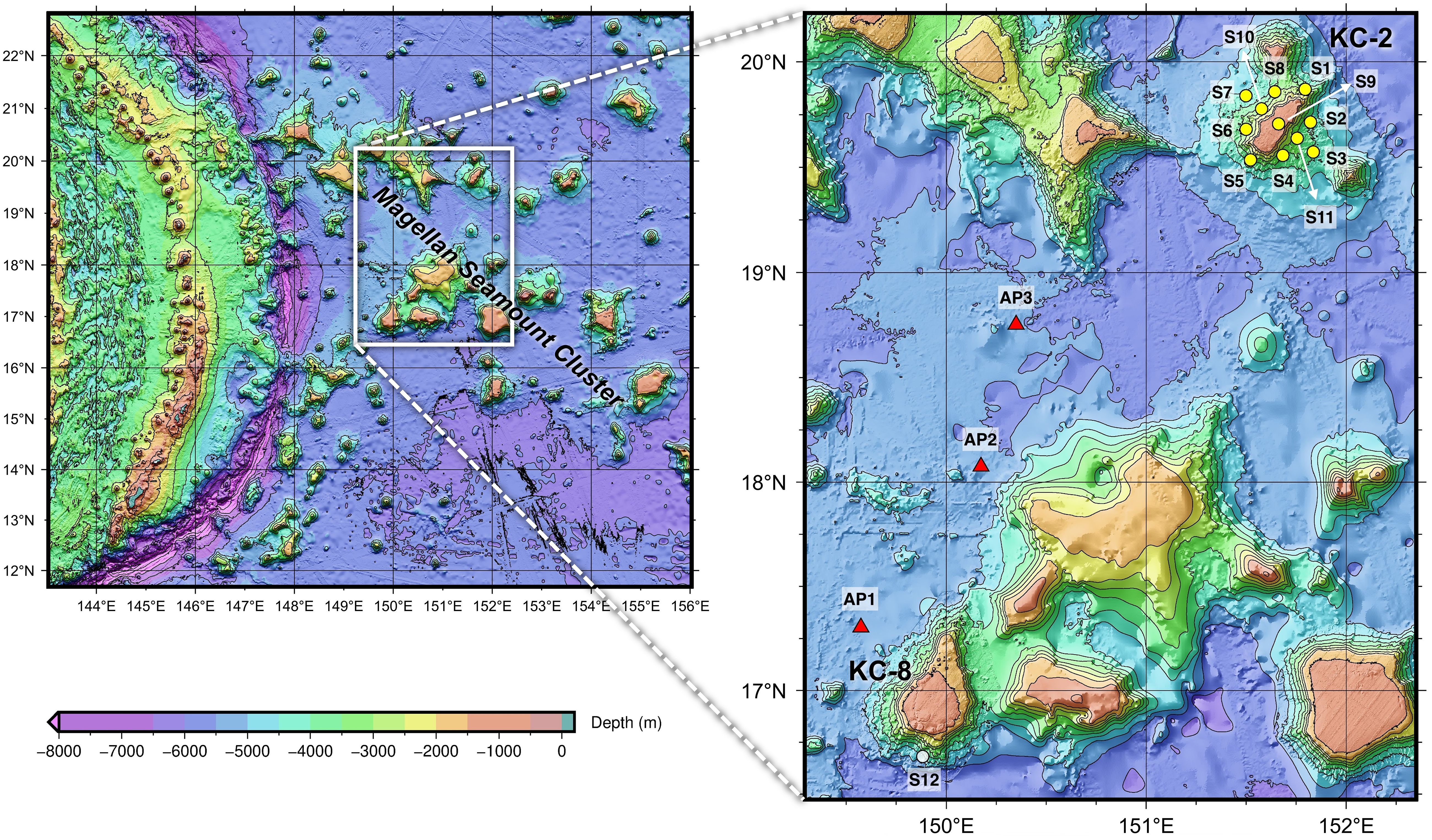
Magellan seamounts and adjacent abyssal plains in the western Pacific Ocean (yellow and white circles represent sample collection sites from the seamount, and red triangles represent those from the abyssal plain).
From EOS by Tim Hornyak
Seamounts may play a significant role in ocean turbulence and the upwelling of deep waters.
Seamounts may play a significant role in ocean turbulence and the upwelling of deep waters.
Undersea mountains could have a big effect on how the ocean circulates, new modeling outputs suggest.
Scientists have long sought to calculate the strength and distribution of ocean mixing and its impact on global ocean circulation and climate.
They have largely been constrained, however, by how little of the seafloor has been mapped.
Tides and oceanic lee waves were thought to be the major forces stirring up the deep ocean.
Seamounts, through their effect on ocean flows, were recognized as another contributing factor.
With recent progress in seafloor mapping, more and more seamounts have been discovered, some thousands of meters tall.
A new study, published in the Proceedings of the National Academy of Sciences of the United States of America, investigates the role of seamounts in deep-ocean mixing.
Water pushed along the slopes of seamounts can generate vortices that mix layers of water that have different temperatures and salinities.
The significance of this turbulence depends on the number and the sizes of seamounts involved.
Scientists were keen to examine how Earth’s rotation and the different strata of the ocean can also influence these wakes.
“The idea of this paper was to evaluate whether such dynamics could be of broad importance in the ocean,” said Ali Mashayek, a climate scientist at the University of Cambridge in the United Kingdom and the study’s first author.
Swirling Waters
Using a seamount data set originally published in 2011, Mashayek and his colleagues established that it is physically possible for turbulence around seamounts to be an important factor in ocean mixing.
The data set is based on gravity data and includes some 24,600 seamounts higher than 100 meters that are located away from the edges of continents.
About 8,500 of the features are more than 1 kilometer tall.
The team also used data on ocean stratification and deep-ocean velocities to show that wake vortices can be large enough to have their dynamics influenced by the rotation of our planet, especially in the Pacific Ocean and across the tropics, a phenomenon that was little appreciated previously, according to Mashayek.
The team found that stirring around seamounts could account for about one third of deep-ocean mixing.
The researchers used three regional simulations spanning equatorial and middle latitudes to demonstrate that elevated mixing and layered wake vortices are common around seamounts.
Rotation and stratification, Mashayek explained, make “vortices that form in the wake of objects break into layers of counter-rotating pancakes, and that creates a lot of friction between the layers and leads to enhanced turbulent mixing.
Without such layering, which would not exist without rotation and stratification, the type of mixing we discuss would not exist.”
Although no physical measurements have verified their modeling outputs, the team found that stirring around seamounts could account for about one third of deep-ocean mixing.
They estimated that in the Pacific, which has more seamounts than other ocean basins, seamount stirring could account for 40% of mixing.
The finding “emphasizes the need to incorporate seamount effects in ocean circulation models,” the researchers wrote.
Mashayek and his colleagues call for improved bathymetric maps to enable better quantification of seamount-driven mixing because of the “potentially significant underestimate” in the number of seamounts previously identified by other researchers.
(The Seabed 2030 initiative, launched in 2017, is only a quarter of the way to generating a complete map of the world’s seafloor.)
Getting a Global Snapshot
The idea that seamounts are a significant contributor to ocean mixing has been around for a couple of decades, said Callum Shakespeare, an ocean dynamics researcher at Australian National University who was not involved in the study.
This study, however, is the first to pin down more concrete numbers at a global scale.
“Seamounts are the steepest features in the global ocean, generating highly nonlinear flow, which has the potential to drive significant mixing, as this study shows,” Shakespeare said.
“However, such nonlinearity also makes it difficult to approach the problem theoretically.”
“However, such nonlinearity also makes it difficult to approach the problem theoretically.”
 A new study used modeling to suggest how and to what extent seamounts affect ocean mixing.
A new study used modeling to suggest how and to what extent seamounts affect ocean mixing.The red and blue markings in this diagram illustrate some of those suggested flows.
Credit: Mashayek et al., 2024, https://doi.org/10.1073/pnas.2322163121
High-resolution numerical simulations are needed, Shakespeare added.
“And it is only recently that such simulations have become feasible.”
The study used an empirical formula to simulate the mixing.
If the signals are as large as the models suggest, however, they should be detectable in real data sets.
“There is an obvious need to conduct further numerical studies to see if this formula holds for other regions,” Shakespeare said, “and obtain observational data to validate the numerical simulations.”
Links :
- Frontiers : Ocean Circulation Over North Atlantic Underwater Features in the Path of the Mediterranean Outflow Water: The Ormonde and Formigas Seamounts, and the Gazul Mud Volcano
- GeoGarage blog : “It’s just mind boggling.” More than 19,000 undersea volcanoes discovered / Undersea mountains stir up currents critical to Earth's climate
No comments:
Post a Comment